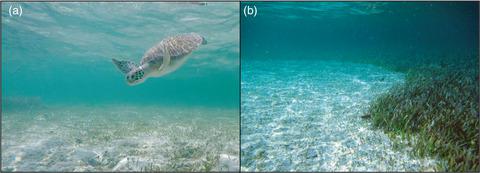Our official English website, www.x-mol.net, welcomes your
feedback! (Note: you will need to create a separate account there.)
Recovery of a cultivation grazer: A mechanism for compensatory growth of Thalassia testudinum in a Caribbean seagrass meadow grazed by green turtles
Journal of Ecology ( IF 5.3 ) Pub Date : 2021-06-04 , DOI: 10.1111/1365-2745.13718 Alexandra G. Gulick 1 , Robert A. Johnson 1, 2 , Clayton G. Pollock 3, 4 , Zandy Hillis‐Starr 3 , Alan B. Bolten 1 , Karen A. Bjorndal 1
中文翻译:

养殖食草动物的恢复:绿海龟放牧的加勒比海草草地中的地中海海藻补偿生长机制
更新日期:2021-08-10
Journal of Ecology ( IF 5.3 ) Pub Date : 2021-06-04 , DOI: 10.1111/1365-2745.13718 Alexandra G. Gulick 1 , Robert A. Johnson 1, 2 , Clayton G. Pollock 3, 4 , Zandy Hillis‐Starr 3 , Alan B. Bolten 1 , Karen A. Bjorndal 1
Affiliation

|
- Recovery of green turtles (Chelonia mydas), mega-herbivores that consume seagrasses, is resulting in dramatic ecosystem-wide changes as meadows are returned to a natural grazed state. The green turtle grazing strategy, with long-term cultivation of meadows and high foraging site fidelity, is distinct from other terrestrial and aquatic mega-herbivores and may affect seagrass compensatory growth responses. Identifying the mechanisms of compensatory growth responses to grazing is essential to understand the functioning of plant systems under natural grazing regimes.
- In a naturally grazed Caribbean seagrass ecosystem, we identify a mechanism for compensatory growth responses to grazing by evaluating relationships between Thalassia testudinum morphology and growth, grazing intensity, and canopy light dynamics in grazed and ungrazed areas.
- The morphological characteristics that explain variability in T. testudinum growth differed between grazed and ungrazed areas. In grazed areas, T. testudinum leaf linear growth, leaf area growth, and productivity:biomass (P:B) significantly increased as above-ground biomass decreased; P:B also increased with shoot density. Mass growth in grazed areas exhibited an increasing trend with shoot density and was maintained above a threshold of 2.5 g dry mass m−2 above-ground biomass. In ungrazed areas, trends for mass growth and P:B with above-ground biomass and shoot density were opposite to those in grazed areas. In grazed areas, shoot density significantly increased with grazing intensity while above-ground biomass decreased and leaf area index (LAI) was not affected. Light availability at canopy height was greater in grazed areas than in ungrazed areas, and canopy light attenuation increased with shoot density in grazed areas.
- Synthesis. Grazing removes above-ground biomass, which increases light availability and stimulates leaf growth and turnover (i.e. compensatory growth). Shoot density increases with grazing intensity, maintaining LAI and canopy light harvesting potential. This maximizes the potential for leaf photosynthetic activity and provides the plant with the capacity to sustain mass growth and support a compensatory growth response to grazing. This study presents novel insight for assessing the underlying mechanisms of plant compensatory growth responses to cultivation grazing and proposes potential thresholds that may be used to evaluate the sustainability of in situ grazing pressure by a recovering mega-herbivore.
中文翻译:

养殖食草动物的恢复:绿海龟放牧的加勒比海草草地中的地中海海藻补偿生长机制
- 随着草甸恢复到自然放牧状态,绿海龟(Chelonia mydas)是消耗海草的大型食草动物,其恢复正在导致整个生态系统发生戏剧性的变化。绿海龟放牧策略具有长期草甸栽培和高觅食地点保真度,与其他陆生和水生大型食草动物不同,可能会影响海草的补偿生长反应。确定对放牧的补偿性生长反应的机制对于了解自然放牧制度下植物系统的功能至关重要。
- 在自然放牧加勒比海海草生态系统,我们确定了补涨反应的机制,通过评估之间的关系放牧Thalassia testudinum形态和生长,放牧强度,和树冠在放牧和ungrazed区光动力学。
- 解释T变异性的形态特征。testudinum放牧和ungrazed区域之间增长的差异。在放牧区,T. testudinum叶片线性增长、叶面积增长和生产力:生物量 (P:B) 随着地上生物量的减少而显着增加;P:B 也随着枝条密度的增加而增加。放牧地区的质量增长表现出随着枝条密度增加的趋势,并保持在 2.5 g 干重 m -2的阈值以上地上生物量。在未放牧地区,地上部生物量和枝条密度的质量增长和 P:B 趋势与放牧地区相反。在放牧区,地上部密度随放牧强度显着增加而地上生物量减少,叶面积指数(LAI)不受影响。放牧区树冠高度处的光可用性高于未放牧区,并且树冠光衰减随着放牧区枝条密度的增加而增加。
- 合成。放牧会去除地上生物量,从而增加光照并刺激叶片生长和周转(即补偿性生长)。枝条密度随着放牧强度的增加而增加,从而保持 LAI 和树冠采光潜力。这最大限度地提高了叶片光合活动的潜力,并为植物提供了维持大量生长和支持对放牧的补偿性生长反应的能力。这项研究为评估植物对耕作放牧的补偿性生长反应的潜在机制提供了新的见解,并提出了可用于评估恢复的大型食草动物对原位放牧压力的可持续性的潜在阈值。











































 京公网安备 11010802027423号
京公网安备 11010802027423号